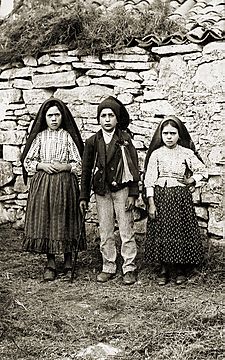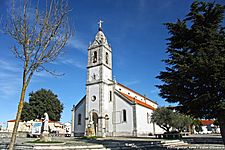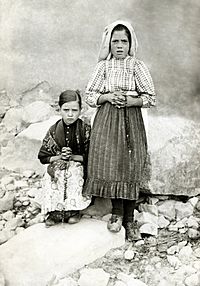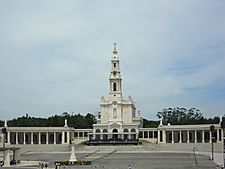Our Lady of Fátima facts for kids
Quick facts for kids Our Lady of FátimaOur Lady of the Holy Rosary of Fátima |
|
|---|---|
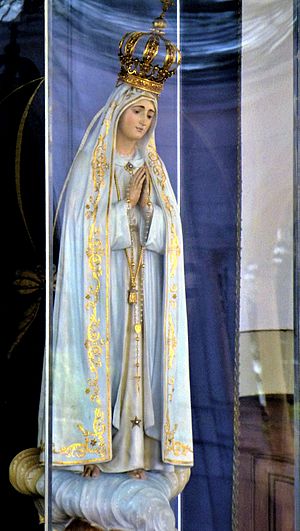
The canonically crowned image enshrined within the Chapel of the Apparitions
|
|
| Location | Fátima, Portugal |
| Date | 13 May to 13 October 1917 |
| Witness | |
| Type | Marian apparition |
| Approval |
|
| Shrine | Sanctuary of Our Lady of Fátima, Cova da Iria, Fátima, Portugal |
| Patronage |
|
| Feast day | 13 May |
Our Lady of Fátima (Portuguese: Nossa Senhora de Fátima) is a special name for Mary, mother of Jesus, in the Catholic faith. This name comes from stories of Mary appearing to three shepherd children in 1917. These events happened in a place called Cova da Iria in Fátima, Portugal. The three children were Lúcia dos Santos and her cousins, Francisco and Jacinta Marto.
The local bishop, José Alves Correia da Silva, said in 1930 that these events were worth believing. Later, in 1946, Pope Pius XII honored a statue of Our Lady of Fátima. This statue is now in the Chapel of the Apparitions in Fátima. The Pope also made the Sanctuary of Fátima a special church called a minor basilica in 1954.
Lúcia dos Santos later wrote down two secrets she said Mary shared with them. A third secret was kept hidden until 1960. These events became famous partly because of the secrets. They were thought to be about World War II and future global conflicts. Mary also asked for the Consecration of Russia to her Immaculate Heart of Mary.
History of the Fátima Apparitions
First Visions of the Angel
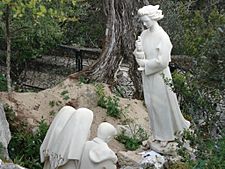
In the spring of 1916, three young shepherd children had some special experiences. These children were Lúcia dos Santos, Francisco and Jacinta Marto. They reported seeing an Angel three times in a place called Valinhos.
Visions of the Lady
Then, starting on May 13, 1917, the children reported seeing the Blessed Virgin Mary six times. This happened in Cova da Iria. The children described her as "a Lady more brilliant than the Sun." She wore a white cloak with gold edges and held a rosary.
The Lady told them that praying would help end World War I. She also said that on October 13, she would reveal who she was and perform a miracle. This miracle would help everyone believe. Newspapers wrote about these predictions, and many people started visiting the area.
The children's stories caused a lot of talk. Some local leaders, both religious and non-religious, were critical. A local official even took the children away for a short time. He thought their stories might be used for political reasons against the government.
On May 13, 1917, the Lady asked the children to pray the Rosary every day. She said this would bring peace to the world and end the war. Jacinta told her family about seeing the Lady, even though Lúcia wanted to keep it a secret. Soon, everyone in the village knew.
The Lady asked them to return on June 13, 1917. Lúcia's mother let them go. Lúcia later said that the Lady told her Francisco and Jacinta would go to Heaven soon. But Lúcia would live longer to share the Lady's message. This message was about devotion to the Immaculate Heart of Mary.
During the June visit, the Lady also showed the children a vision of a place of suffering. She also shared a secret with them. Father Ferreira, the local priest, said Lúcia told him the Lady wanted her to learn to read.
In the months that followed, thousands of people came to Fátima. They were drawn by the stories of visions and miracles. On August 13, 1917, a local official named Artur Santos took the children into custody. He wanted them to tell him the secrets. Lúcia told him everything except the secrets.
Instead of the usual apparition on August 13, the children reported seeing the Virgin Mary on August 19. This happened in nearby Valinhos. She again asked them to pray the rosary daily. She also spoke about the miracle coming in October. She asked them to "pray a lot for sinners" and "make many sacrifices." She said many souls suffer because no one prays or makes sacrifices for them.
The three children said they saw the Blessed Virgin Mary six times in total. This was between May 13 and October 13, 1917. Lúcia also reported a seventh vision later. In 2017, Pope Francis visited the Sanctuary of Fátima to celebrate 100 years since the first visions.
Messages from the Lady
The Lady spoke many words to the children. Here are some of them:
- May 13, 1917: "Do not be afraid. I am from Heaven. I came to ask you to come here on the thirteenth day for six months at this same time. Then I will tell you who I am and what I want. And afterwards, I will return here a seventh time." She asked if they would offer themselves to God and accept sufferings for sinners.
- June 13, 1917: "I want you to come on the thirteenth day of next month and to pray the Rosary every day. I want you to learn to read." She said Francisco and Jacinta would go to Heaven soon. But Lúcia would stay to make Mary better known and loved. Mary promised, "My Immaculate Heart will never abandon you, but will be your refuge and the way that will lead you to God."
- July 13, 1917: "Continue to pray the Rosary every day... to obtain peace for the world and the end of the war." She promised a miracle in October so everyone would believe. She showed them a vision of a place of suffering. She said, "God wishes to establish in the world devotion to my Immaculate Heart." She warned that if people did not stop offending God, another worse war would begin. She asked for the consecration of Russia to her Immaculate Heart. She said, "If people attend to my requests, Russia will be converted and the world will have peace."
- August 19, 1917: "Pray, pray a great deal and make many sacrifices, for many souls go to Hell because they have no one to make sacrifices and to pray for them."
- September 13, 1917: "You must pray! Continue to pray the Rosary every day in order to obtain the end of the war." She said God was pleased with their sacrifices.
- October 13, 1917: "I am the Lady of the Rosary. I have come to warn the faithful to amend their lives and ask for pardon for their sins. They must not offend Our Lord any more, for He is already too grievously offended by the sins of men. People must say the Rosary. Let them continue saying it everyday. I would like a chapel built here in my honor. The war will end soon."
The Miracle of the Sun
Newspapers reported that the Virgin Mary promised a miracle for her last appearance on October 13. A huge crowd, possibly between 30,000 and 100,000 people, gathered at Cova da Iria. What happened next became known as the "Miracle of the Sun."
Many people described seeing the Sun appear as a spinning disc in the sky. It was said to be duller than usual and cast colorful lights. Some reported the Sun moving towards the Earth before returning to its normal place. Witnesses also said their wet clothes and the muddy ground became dry instantly.
Not everyone saw the same thing. Some only saw the colors, and others saw nothing unusual. Scientists at the time did not observe any strange solar events. Skeptics suggest explanations like people staring at the Sun, or natural weather effects.
The children had reported that the Lady said World War I would end on October 13, 1917. However, the war actually ended a year later, on November 11, 1918.
Later Lives of the Children
Francisco and Jacinta Marto died during the global flu pandemic that spread from 1918 to 1920. Francisco died on April 4, 1919, at age ten. Jacinta died on February 20, 1920, at age nine. Their mother said the children had predicted their own deaths. They are now buried at the Sanctuary of Fátima. They were made saints by Pope Francis on May 13, 2017.
Lúcia became a nun at age fourteen. She continued to report private visions throughout her life. In 1925, she said the Virgin Mary asked her to share the message of the First Saturdays Devotion. In 1929, Lúcia reported that Mary repeated her request for the Consecration of Russia to her Immaculate Heart.
Lúcia wrote in her memoirs that Mary had predicted the deaths of Francisco and Jacinta. She said Mary told her, "Yes, I shall take Francisco and Jacinta soon, but you will remain a little longer, since Jesus wishes you to make me known and loved on Earth."
Sister Lúcia died on February 13, 2005, at the age of 97. Her path to becoming a saint is currently being studied by the Church.
Pilgrimage to Fátima
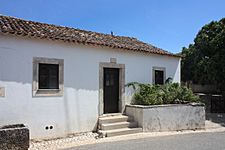
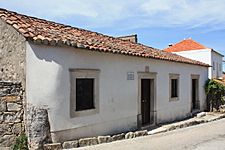
The "Miracle of the Sun" quickly made Fátima a very important place for pilgrims. Millions of people visited the site in the ten years after 1917. A small chapel, called the Capelinha, was built where the visions happened.
In 1930, the Catholic Church officially recognized the apparitions as "worthy of belief." This meant people were allowed to believe in Our Lady of Fátima. The Church also allowed special prayers and services there.
Today, people visit Fátima all year round. The biggest gatherings happen on the 13th day of each month from May to October. These are the anniversaries of the original visions. Huge crowds, sometimes up to a million pilgrims, pray and watch processions of the statue of Our Lady of Fátima.
Church's Official View
The stories of the Fátima visions gained a lot of attention. After a careful study, the Bishop of Leiria-Fátima officially said in October 1930 that the visions were "worthy of belief." This allowed people to openly show devotion to Our Lady of Fátima.
Political Connections
When the visions happened, Portugal was going through a time of change. The government was trying to separate church and state. This caused tension with more traditional groups. Later, in Spain, some Catholic groups used images of the Virgin Mary to protest against groups they called anti-religious.
The Fátima visions became important to conservative groups in Portugal and Brazil. They saw it as a way to stand against ideas like Communism. When Germany invaded Russia in 1941, some Catholics thought it was a sign related to the Fátima prophecies.
The children said the Lady talked about praying for Russia. Lúcia later said they first thought she meant a girl named "Russia." After World War II began, Sister Lúcia wrote more about Russia. The Lady's warning that "if Russia was not consecrated to God, it would spread errors throughout the world" became a strong anti-Communist message.
Groups like the Blue Army of Our Lady of Fátima (now called the World Apostolate of Fátima) are strongly anti-Communist. They believe that daily prayer, especially the Rosary, can bring world peace and end the spread of Communism. The Catholic Church has approved these organizations.
Sister Lúcia's Memoirs
The story of Fátima became widely known outside Portugal and Spain when Lúcia published her memoirs. She wrote six memoirs between 1935 and 1993. The first four were published as Fatima in Lucia's Own Words. The later ones were published as Fatima in Lucia's Own Words II.
In her memoirs, Sister Lúcia shared more details about the 1917 apparitions. She also wrote about earlier visions of the Angel of Peace. She explained that she wrote these books to answer the many questions people had about the visions and messages.
The Three Secrets of Fátima
In her third memoir, written in 1941, Sister Lúcia described three secrets. She said these were given to the children during the 1917 visions.
First Secret
This was a vision of a place of suffering, which Lúcia said they saw on July 4, 1917. She described it as a "vast sea of fire" with dark, human-like figures floating in it. She said it was a very scary sight.
Second Secret
This secret was about devotion to the Immaculate Heart of Mary. It was presented as a way to help souls and bring peace. It predicted the end of World War I. But it also warned of a worse war if people did not stop offending God. This second war would be signaled by a strange light in the sky. To prevent it, Mary would ask for the consecration of Russia to her Immaculate Heart. She also asked for the First Saturdays Devotion. If her requests were followed, Russia would change, and there would be peace. If not, Russia would spread its ideas, causing wars and harm to the Catholic Church. The vision ended with a promise that Mary's Immaculate Heart would win in the end.
On January 25, 1938, a bright aurora borealis appeared over the Northern Hemisphere. Sister Lúcia believed this was the "great sign" Mary had spoken of. Soon after, major events leading to World War II began.
Consecration of Russia
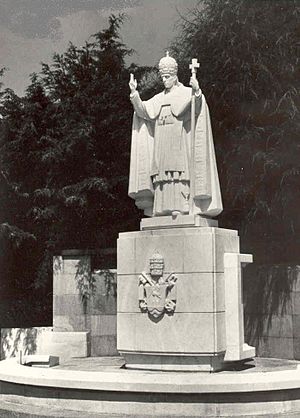
According to Sister Lúcia, the Virgin Mary promised that consecrating Russia would lead to its change and a time of peace.
Pope Pius XII consecrated the human race to the Immaculate Heart of Mary in 1942. He specifically mentioned "peoples of Russia." Later, Pope John Paul II consecrated the entire world to the Virgin Mary in 1984. Some believe this fulfilled Mary's request. Sister Lúcia herself stated in 1990 that the consecration had been completed.
In 2022, during the conflict in Ukraine, Ukrainian bishops asked Pope Francis to consecrate Ukraine and Russia to the Immaculate Heart of Mary. Pope Francis did this on March 25, 2022, at Saint Peter’s Basilica.
Third Secret
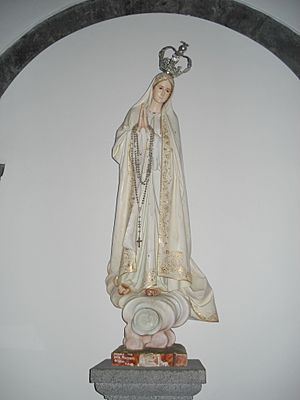
The third secret was a vision of a Pope and other religious figures suffering and dying. Lúcia described seeing an Angel with a flaming sword. The Angel cried out, "Penance, Penance, Penance!" Then they saw a Bishop in white, who they thought was the Pope. He walked through a city in ruins, praying for the dead. He reached a large cross on a mountain and was killed by soldiers. Other bishops, priests, nuns, and regular people also died. Two Angels gathered their blood and sprinkled it on souls going to God.
Fátima Prayers and Acts of Reparation
Many Catholics say prayers based on the Fátima apparitions. Lúcia said that in 1916, an angel taught them a prayer: "My God, I believe, I adore, I hope, and I love you. I ask pardon for those who do not believe, do not adore, do not hope and do not love you."
Lúcia also said the Lady stressed the importance of making sacrifices and prayers to comfort Jesus for the world's sins. Mary's words were, "When you make some sacrifice, say 'O Jesus, it is for your love, for the conversion of sinners, and in reparation for sins committed against the Immaculate Heart of Mary.'"
The children were so moved by the vision of suffering that they began to make many personal sacrifices. Lúcia wrote that they wore tight cords, used stinging nettles, gave their lunches to beggars, and sometimes did not drink water on hot days. Francisco and Jacinta were very dedicated to these practices.
Lúcia also said Mary asked for a special prayer to be added to the Rosary: "O my Jesus, pardon us, save us from the fires of hell. Lead all souls to heaven, especially those in most need."
The "conversion of sinners" in the Fátima message means people turning away from bad actions and living according to Jesus' teachings. It does not necessarily mean changing to the Catholic Church. Lúcia said "sinners" were those who had fallen away from the Church or did sinful things, especially "sins of the flesh" and being unfair or unkind to the poor.
Church Approval and Popes
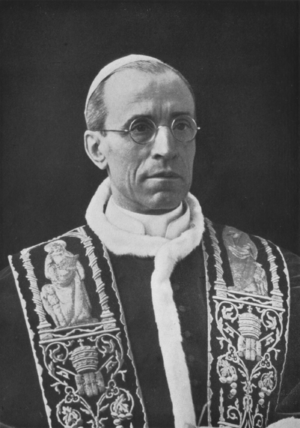
The Church has officially supported devotion to Our Lady of Fátima. In October 1930, the Bishop of Leiria-Fátima declared the apparitions "worthy of belief."
Pope Pius XII
- Pope Pius XII was consecrated as a bishop on May 13, 1917, the day of the first apparition. He became known as "the Pope of Fátima."
- In 1940, Sister Lúcia asked Pope Pius XII to consecrate the world and Russia to the Immaculate Heart of Mary.
- On October 31, 1942, Pope Pius XII spoke about the Fátima apparitions and consecrated the human race to the Immaculate Heart of the Virgin, mentioning "peoples of Russia."
- On May 13, 1946, a special ceremony crowned the statue of Our Lady of Fátima.
- On November 11, 1954, he made the Fátima sanctuary a basilica.
Pope Paul VI
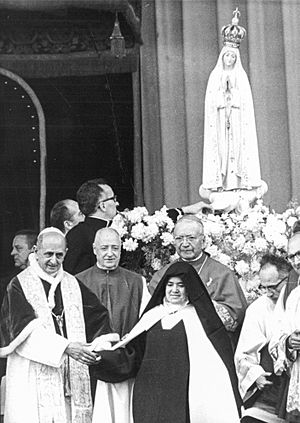
Pope Paul VI renewed the consecration to the Immaculate Heart of Mary. He also made a pilgrimage to Fátima on May 13, 1967, the 50th anniversary of the first apparition. He prayed at the shrine with Sister Lúcia.
Pope John Paul II
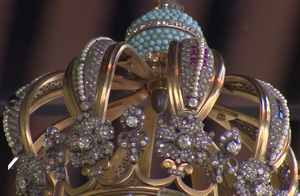
Pope John Paul II consecrated "the world" to the Virgin Mary in 1984. He believed Our Lady of Fátima saved his life after an assassination attempt on May 13, 1981, which is the Feast of Our Lady of Fátima. He later placed one of the bullets from the attack into the crown of the Fátima statue.
Pope Benedict XVI
On May 12–13, 2010, Pope Benedict XVI visited the Sanctuary of Our Lady of Fátima. He clearly stated his belief in the Fátima apparitions. He gave a Golden Rose to Our Lady of Fátima as a sign of thanks. He also spoke about the "invisible hand" that saved Pope John Paul II.
Pope Francis
In March 2022, during the conflict in Ukraine, bishops asked Pope Francis to consecrate Ukraine and Russia to the Immaculate Heart of Mary. Pope Francis did this on March 25, 2022, at Saint Peter’s Basilica in Rome. He said, "Mother of God and our mother, to your Immaculate Heart we solemnly entrust and consecrate ourselves, the church and all humanity, especially Russia and Ukraine."
Sainthood
In March 2017, the Church announced that Pope Francis would make Francisco and Jacinta Marto saints. This happened on May 13, 2017, during his visit to Fátima. The decision came after a miracle was confirmed through their prayers.
Sister Lúcia's process to become a saint is still ongoing. She is currently called a Servant of God.
Other Images of Our Lady of Fátima
Many statues of Our Lady of Fátima are well-known:
- The Immaculate Heart of Mary statue at the Fátima shrine. Sister Lúcia said this one looked most like her visions.
- The statue in the Chapel of Apparitions was crowned in 1946. Pope John Paul II added the bullet from his assassination attempt to its crown.
- Copies of the International Pilgrim of Fátima statue have traveled around the world.
- The U.N. Virgin Fátima statue once stood in the Headquarters of the United Nations in New York City.
- Our Lady of Fátima is part of the Quyllur Rit'i festival in Peru.
- The National Pilgrim Image of Our Lady of Fátima-Philippines is a gift to the Philippines. It was important during the peaceful People Power Revolution in 1986.
|
See also
 In Spanish: Virgen de Fátima para niños
In Spanish: Virgen de Fátima para niños
- Alexandrina of Balazar
- Blue Army of Our Lady of Fátima
- Consecration and entrustment to Mary
- Fatima Movement of Priests
- Fátima, Portugal
- First Saturdays Devotion
- Mary of the Divine Heart
- Parish Church of Fátima
- Pontevedra apparitions
- Pope John Paul II assassination attempt
- Rosary and scapular
- Sanctuary of Christ the King
- Sanctuary of Our Lady of Fátima
- Signum Magnum (apostolic exhortation)


